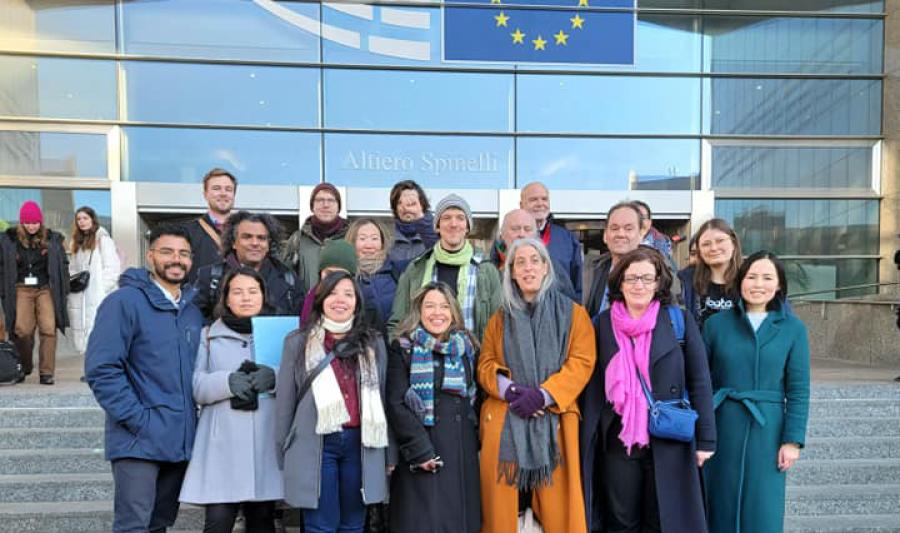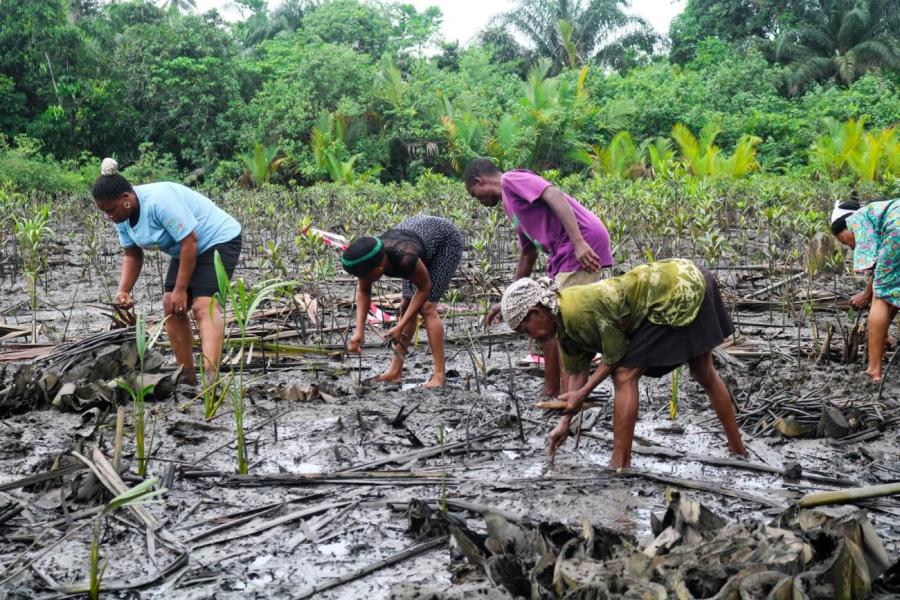The Hagahai are a recently contacted group of seminomadic hunter-horticulturalists living in the fringe highlands of Madang Province in Papua New Guinea. Although occasional explorers and miners probably walked through their territory in the Schrader Mountains as early as the 1930s and several attempts were made to census them during the 1970s, the Hagahai effectively remained hidden from mission and government influence until the 1980s. In late 1983 several Hagahai men, recognizing a steady decline in their population, walked across the Yuat River to a mission station in the Baiyer River Valley to request medical aid. The first Baptist missionary was stationed among the Hagahai in April 1984: in July of the same year a team from the Papua New Guinea Institute of Medical Research accompanied the first moderately successful census patrol into the area. A scant population remote from administrative head-quarters, the Hagahai represent one of the most isolated peoples in contemporary Papua New Guinea.
Epidemics of newly introduced infectious diseases began to affect the Hagahai seriously around the time of World War II, when trade for steel axes escalated in their region. Survivors from that time describe what appears to be a combination of influenza and dysentery, which decimated the population. Other epidemics reached them again in the 1960s, when the Simbai Patrol Post opened several day's walk from their territory. Fearing the effects of contact wit outsiders, elders forbade the young to wander beyond their borders, effectively enforcing group isolation. Neighboring fringe highlanders seldom ventured into Hagahai territory for fear of malaria. Except for the rare adventurer, no one went in or out of Hagahai territory for decades.
The Hagahai now number about 300 persons - members of five named territorial groups (Aramo or Ginam, Luyaluya, Miyamiya, Mamusi and Pinale), ranging in size from 18 to 120. Across the Yuat River lives another closely related group called the Pinai, who were censused in 1970 at 243 persons. A more distantly related sedentary horticultural people known as the Haruai or Kombolo live to the east and were studied in 1978-1980 by Flanagan. Linguistic evidence suggests that these groups are all members of the same language family, unrelated to the other languages of the Schrader Range. Genetic evidence points to a lowland, possibly Sepik, origin for these peoples. Future archeological investigations may help to determine how long the Hagahaiand their ancestors have been living in the area.
Current Health Status
Medical and anthropological studies conducted among the Hagahai from 1984 to the present reveal a population under extreme disease pressure. Counting 289 persons living on the Madang side of the Yuat River between September 1985 and September 1986, the crude birth rate for that year came to 33 per 1,000, with a crude death rate of 46 per 1,000. The infant mortality rate was 444 per 1,000. Although they have had access to some health care since 1984, their situation has not improved substantially. Between September 1986 and September 1987, nine of the 13 infants born have died.
The causes of this high mortality are multiple. Serological surveys done in 1985 show that the Hagahai had not been exposed to measles, rubella, tetanus, several varieties of polio, parainfluenza and other respiratory viruses common in Papua New Guinea. By late 1986, however, the population had experienced epidemics of influenza A. mumps and hepatitis B. Rubella, chloroquine-resistant malaria and penicillin-resistant strains of Streptococcus pneumonia also had entered the area. Between September 1986 and June 1987 at least six deaths in adults and children were attributed to a virulent form of unidentified dysentery.
This heavy load of epidemic disease might be particularly lethal to the Hagahai due to the effects of poor nutrition and malaria on their immune status. The Hagahai are one of several peoples in Papua New Guinea who suffer from hyperactive malarious splenomegaly (HMS), once called tropical splenomegaly syndrome. Although enlarged spleens in children are not unusual among people living in regions with highly endemic malaria, the condition usually disappears by the time full immuno-competence is acquired in early adolescence. Those who are afflicted with HMS retain grossly enlarged spleens and high immunoglobulin levels into adulthood, indicating a hyperactive response to malaria.
In area of Papua New guinea where long-term studies of this syndrome have been performed. HMS carries a mortality of over 50 percent by age 30, preceded by an acute infection. If the speculation can be substantiated that HMS is an inherited adaptation to malaria, then the Hagahai represent an interesting but pathetic example of a people whose biological advantage turned into a self-destructive autoimmune disease under the impact of newly introduced infections.
Nutritional Status and Subsistence
The Hagahai's nutritional status is currently marginal. It is impossible to ascertain their nutritional status and dietary regime of the people prior to the onslaught of introduced diseases and the influence of the missionaries. Although they plant gardens (in a less intensive manner than other highland and fringe highland peoples), they do not appear to depend on them for most of their food. They plant, often thinly, only a limited number of traditional species; by contrast, their wild food plants so far number over 80. They occasionally process sago starch, but sago palms are not plentiful. The Hagahai actually appear to manage the forest, tending volunteer or deliberately planted tree corps and moving frequently about their territories in order to harvest these during hunting-foraging excursions. Garden foods, particularly bananas, provide an important carbohydrate source when forest sources are scanty. The lack of animal protein, however, limits long-term residence at garden sites. Hence, the Hagahai regularly move about their territories, sleeping in small lean-tos, rock shelters or on the open forest floor.
Their terrain of mixed forest and grassland spans a wide altitude range (from 200 to 1,800 meters) and possesses a great variety of game animals, including pigs, cassowaries, lizards, snakes, marsupials, birds, eel and catfish. Pigs are sometimes raised, but present a limiting factor in the Hagahai seminomadic life-style - more appear to be raised now than in the past. Anthropologists are investigating whether the Hagahai represent displaced sago-dependent foragers who have adopted some minimal horticulture, or horticulturalists who have shifted away from gardening under demographic stress or for other reasons.
Nutritional status assessments of children are severely hampered by lack of known ages or reference points from which to construct a local events calendar. Based on weight-for-length alone, 10 percent of the children under five years old are wasted - that is, they fall below 2 s.d. of median international reference values. By the age of seven, when children are able to secure much of their own food, wasting virtually disappears. Severe wasting appears again during bouts of illness and is marked in adults. Frequent illness coupled with high male mortality rates severely cripples the family food quest. Variations in weight as great as 20 kg among adults have been recorded in the same month over a three-year period, depending largely on the extent of recent morbidity. Although it is difficult to document with precision, it appears that nutritional status declines among families who remain close to the mission station. This may be due, in part, to the greater frequency of disease transmission in areas with increased population density. Nutritional status also appears to suffer from lack of access to traditional hunting-and-gathering grounds among those families who have been persuaded to build houses near the mission base and become more sedentary.
Demographic Factors
In addition to suffering deaths from disease, accident and snake bite, the Hagahai practice infanticide. A population pyramid very skewed toward males suggests preferential female infanticide, although informants claims they kill male as well as female children. Infants are killed for various reasons, including (1) the mother's reluctance to breastfeed, (2) the presence of many children in a family and (3) the deaths of previous children in the family. Missionaries have threatened to have parents who practice infanticide jailed, which has led to surreptitious infanticide under the guise of fatal illness.
Traditional marriage patterns are endogamous within the named territorial group with preferred cross-cousin sister exchange and no bride price. As such marriages are very difficult to arrange in practice, most marriages are essentially by capture or elopement. Marriage age is traditionally quite late - about 25 for females - though recently this practice seems to be changing. Only young widows tend to remarry, and then usually many years after the husband's death. Some widows never remarry out of fear of the deceased husband's ghost. The crude birth ate calculated for 1986 of 33 per 1,000 is not low by Papua New Guinea norms, and the Hagahai bear no evidence of impaired fertility.
Outsiders and the Hagahai Future
Despite a few census patrols, government interference with the Hagahai is virtually nonexistent. The only outsiders who exert any influence on the people are missionaries from the Western Highlands Baptist Union and myself and my research team. In 1986 the government posted a village-level medic among the Hagahai. The missionaries who come and go from the Hagahai have varied considerably in the extent to which they seek to alter traditional culture. But even the least interfering missionary, a kind man with medical training, might have inadvertently helped to spread an epidemic of hepatitis B through inadequate sterilization of needles. He also took at least a dozen men with him to his mission headquarters at various times and even traveled with five men to Lae, a city on the coast. One influenza epidemic is directly traceable to such a visit; the pattern of disease spread for several other infections, including mumps, suggests transmission through these travelers.
In addition, the mission has encouraged the Pinai people from across the Yuat River to build cane bridges. The missionary children have been encouraged to live among the Hagahai to receive schooling in Melanesian Pidgin and religion. The Pinai have been in greater contact with highland peoples for a longer time than the Hagahai and have adopted practices such as the bride price and demands for compensation after every death. Because the Pinai and Hagahai are traditional enemies, this newly enforced close contact has created numerous conflicts, including a fight in 1986 during which the Pinai raided and destroyed the houses and gardens of Hagahai families living near the mission base. Any verbal insult directed toward a Pinai or the death of a Pinai who has even briefly visited the Hagahai evokes a threatening demand for compensation. Because the Hagahai have no source of cash and raise few pigs, they find it nearly impossible to answer these demands. Unfortunately, the missionaries, who are members of Western Highlands societies, do not recognize the problem they have created, but view demands for compensation as a normal aspect of social life. The Hagahai, who never developed these practices, now feel very threatened by the more acculturated, dominant Pinai and have tried to convince the missionaries to send them back across the river.
My own field work among the Hagahai, so far totaling about nine months, may also have had an impact on them. Because infected team members are never allowed to enter the area and only disposable needles are used, we hope that we have not introduced new diseases. However, we have met requests from the Hagahai for matches, salt, soap and occasionally clothes or food, in exchange for pelts, bows and arrows, stone axes and bush foods. We have also given them hooks and line for fishing an, for major informants, bush knives. Naturally, they want more - our flashlights, cooking pots, kerosene lamps and, more recently, cash. This places us in the dangerous position of becoming traders to the Hagahai, a role we must necessarily keep very limited without appearing ungenerous. Luckily, as long as the only feasible way to enter the area is by helicopter, space limitations offer a reasonable explanation for not bringing in more trade goods. Flow in trade will probably increase when the missionaries succeed in their plans to build an airstrip (which is halfway completed).
With the aid of Save the Children Fund, Rotary International, Lions, Apex and Lioness charities, we have raised funds for a solar refrigerator and a much-needed vaccination campaign, which is currently underway. We have brought in a better-trained and enthusiastic young man as well as a part-time female nurse to replace the previous, inadequate workers. We intend to continue to monitor the demographic situation, health and nutritional status and cultural adaptations of the Hagahai as they experience their first years of direct contact with the world around them. It is also imperative that we help protect the Hagahai from biological and cultural extinction by providing direct feedback to the mission headquarters of the consequences of their activities and by exerting pressure as a national health research body to have negative practices ceased. The next five years should tell the story of our success or failure.
Article copyright Cultural Survival, Inc.



